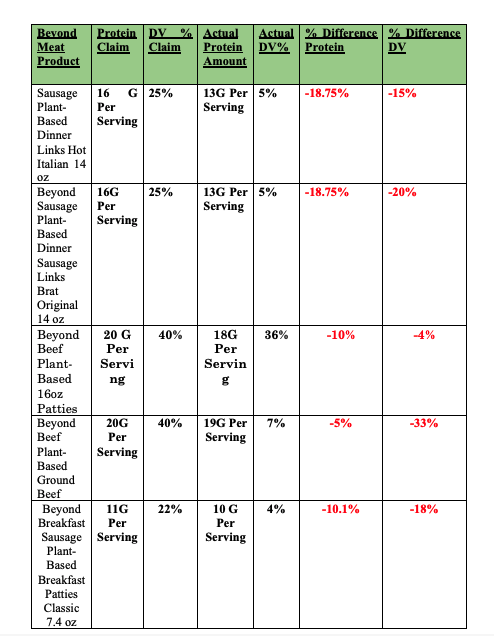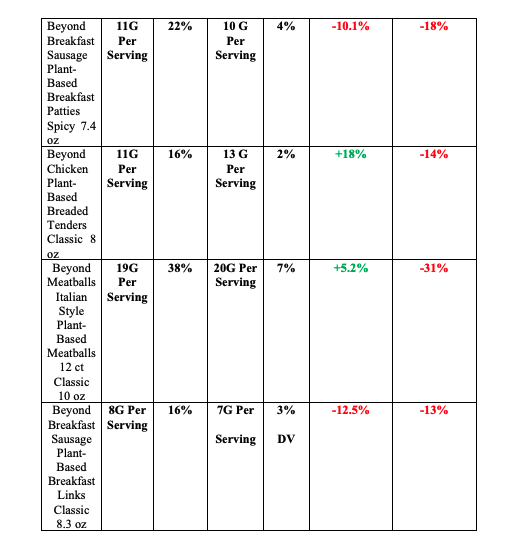Schadenfreude. That’s the theme for today. No one who reads this actually eats the Beyond Meat product, so this article won’t change any minds. However, we may occasionally allow ourselves the luxury of a good gloating session, and some optimism that perhaps justice isn’t so slow all the time.
The case was filed in the U.S. District Court for the Northern District of Illinois (Eastern Division). The entire filing can be read here.
What’s the complaint about Beyond Meat?
The TL;DR is that Beyond Meat is being sued for false and misleading claims regarding the protein content of their various sludges. The suit alleges that the protein content is miscalculated and that the quality is vastly overstated (represented as a percent daily value).
The protein in a food product is determined by the “Nitrogen Content Method”, also called the Kjeldahl method. It’s an indirect way to measure protein content by looking at the total nitrogen content bound up in an organic molecule, then using a conversion factor to convert nitrogen content to protein content.
Without diverting too far on a chemistry tangent here, we’re all aware that “protein” is a massive term that encompasses thousands of different types of molecules whose structures and compositions can vary wildly (think even about the list of amino acids you need for body building and look up the chemical structures sometime), and many proteins have nothing to do with our food or supplements (for instance, the COVID-19 and related vaccines’ spike proteins). In practice, the USDA uses the conversion factor of 6.25 times the nitrogen content in the food product as a rule of thumb for just about every food, so in reality, this isn’t a very reliable method for determining protein content in processed foods.
The Food, Drug and Cosmetics Act (in the United States) requires the disclosure of protein quality as well to calculate a “corrected amount of protein per serving”, and corrects for the digestibility of the protein. The percent daily value of the protein content of a food must be calculated using this correction method.
The plaintiffs in the lawsuit submitted various samples of Beyond Meat products for more rigorous protein analysis and found that the actual protein content and the reported percent daily value were quite a bit off of Beyond Meat’s product labels. Of particular interest is the below chart, which I’ve reproduced from the lawsuit filing.


If you need a program or diet plan, check out our DEMIGOD Bundle here.
Comments and Corrections
I’m certainly not the first person to write on this lawsuit, but I think I may be the first to publicly point out the errors in mathematics in the lawsuit. The chart paints a clear picture of deception by Beyond Meat, in my opinion, but the calculations are way off. Beyond Meat is worse than even this lawsuit claims. The “percent difference” column is incorrect. By only taking the absolute difference in percent, the lawyers aren’t doing the proper comparison. To help you through this reasoning, think of “percent daily value” as “per hundred daily value”, as in “there are 5 parts per hundred” rather than “5%”. This will help us not get lost in the different percentage calculations we’ll be making.
Let’s take the “Beyond Meatballs Italian Style Plant-Based Meatballs” as an example. The reported percent daily value is 38%, with the actual as 7%. The lawyers report this as a “percent difference” of 31%, but this is incorrect. The actual is 7%, which is less than 1/5 the value of 38%. (Watch your units here.) So in fact, Beyond Meat inflated the percent daily value by over 5 times the actual percent daily value.
If you don’t like this much arithmetic, let’s rephrase this a different way: how many servings of Beyond Meatballs would you actually have to eat to get the claimed 38% daily value? If one serving gives you 7%, then you’ll need to eat 5.42 (which is 38/7) servings of Beyond Meatballs to get that claimed daily value. That’s not a difference of 31%, as the chart claims, that’s a difference of 442%. (To understand how this is calculated, visit here. Your starting value is 7, and finishing value is 38. you can compare directly and forget the “percent” because you’re comparing things of the same units–apples to apples.) Beyond Meat overstated the percentage daily value of the protein content in its meatballs by 442%, or 5.42 times the actual value. You can repeat this calculation with all of the others in the chart as well.
The lawyers’ case is actually much stronger than they originally report in their filing. My expertise is in mathematics (by training), not law, but it stands to my reasoning that the amount of damages that Beyond Meat could be sued for would increase appropriately with the scale of the deception.
At any rate, those of us who eat real food don’t need complex analytical chemistry to tell us what’s healthy and what isn’t. Perhaps this should be a lesson to other people–if you need advanced degrees in chemistry to determine whether or not what you’re eating is good, then you probably shouldn’t eat it.
Update: (6/16/2022). I received a fantastic comment from Matthew in the Telegram channel, and am reproducing it in its entirety here. This is a concise, elegant way to convince those in your life that “plant-based” is not equivalent to animal protein.
“Protein information applies to every food item. 10 grams of protein from plants is not equal to 10 grams of protein from meat. It is possible to get a complete aminogram from plants alone (you have to combine them properly and know how), only at the expense of the carbohydrates taken in. Thus, weight reduction while on a diet without meat is not easy, if at all possible.“
– Matthew
(P.S. Interested in more mathematics writing? Visit my site here.)
If you need a program or diet plan, check out our DEMIGOD Bundle here.
Don’t hesitate to email us at [email protected] for personalized coaching and a client questionnaire if you’d like DEDICATED tailor-made personal training on strength training, building muscle, losing fat, developing athleticism, and more — all to your liking, lifestyle, habits, and taste!
Otherwise, don’t forget to claim your FREE eBook detailing how to lose 20lb of fat while building muscle in 12 weeks! You can claim it here.
Alternatively, you can pick up a FREE eBook on fundamental strength principles offering an introductory workout program.












